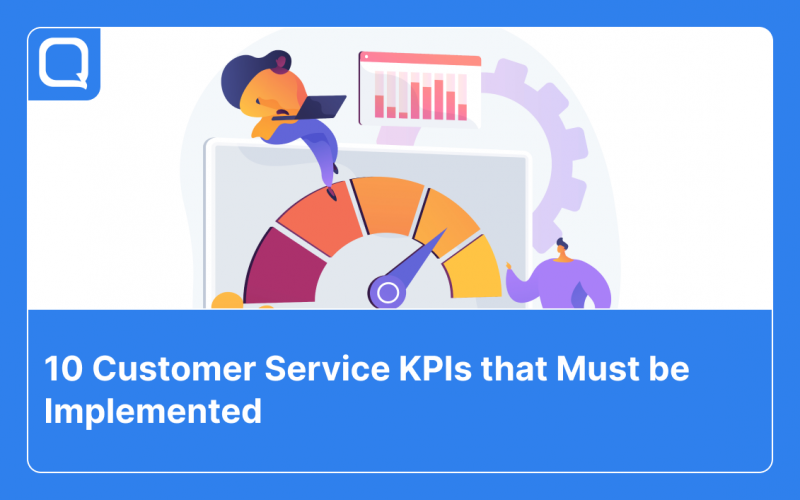Did you know that one of the sources of business revenue growth comes from excellent customer service? This is evidenced by McKinsey’s report, which states that customer service can double business revenue. Therefore, it’s time for you to enhance your customer service performance with customer service KPI.
What are Customer Service KPI?
Key Performance Indicators are parameters of business success in achieving its goals. When applied to customer service, customer service KPIs are measures of a customer service representative’s performance success.
As a customer service manager, you should have already established several indicators to measure the success of your customer service. The performance of the CS team itself will influence a customer’s purchasing decision, where Gartner states that 80% of customers will buy products from businesses that provide excellent customer service.
Therefore, in this article, we will dissect together about customer service KPIs that you can implement for your customer service team.
READ MORE: How to Send Messages to Multiple People on WhatsApp
Examples of Customer Service KPI
There are various customer service KPIs that you can choose and start implementing for your customer service team. The following 10 customer service KPIs hopefully can provide an overview of which indicators are suitable for measuring your CS team’s performance.
1. First Contact Resolution (FCR)
First contact resolution (FCR) is an indicator that shows how often your CS team resolves customer issues on the initial contact. For example, if a customer has a payment issue and contacts your CS team for a solution, and your CS team successfully provides a response within 10 minutes.
A high FCR percentage indicates that your CS team is able to resolve customer issues more quickly and efficiently.
2. Average Handling Time (AHT)

Average handling time (AHT) is the average time it takes to respond to messages or resolve customer issues. Here, you can establish an ideal time limit for your customer service team to resolve customer issues.
A low AHT indicates that your customer service team successfully resolves customer issues quickly.
3. Customer Satisfaction

One of the most common KPIs or indicators you can use is customer satisfaction. To measure customer satisfaction, you can ask your CS team to directly gather feedback from customers. This feedback can also be represented by customers giving ratings to your store on your marketplace.
Conduct customer satisfaction surveys regularly, preferably weekly if possible. If not, you can send customer satisfaction surveys once a month. Use a CSAT (Customer Satisfaction) application to facilitate the delivery and recording of your customer satisfaction survey data.
4. Customer Effort Score (CES)
Customer effort score (CES) is an example of a customer service KPI that illustrates how easily customers can resolve their issues through your CS team. CES can be measured through surveys you conduct.
An example question to measure CES is “Based on the solution we provided, how easy was it for you to resolve the issue you had?” It’s important to note that issue resolution itself doesn’t necessarily mean without guidance or solutions from your CS team. Rather, it’s about how customers then resolve their issues based on the guidance you provided.
READ MORE: Customer Data Platform: Advantages & How It Works
5. Net Promoter Score (NPS)

Net Promoter Score (NPS) is the likelihood of your customers recommending your product to others. The value of NPS can be determined through customer surveys. It’s advisable to send out NPS surveys some time after a purchase.
An example NPS question you can use is “How likely are you to recommend this product to your friends or family?” From the answers to this question, you can gauge how satisfied customers are with the products and services you provide.
6. Escalation Rate
Escalation rate is a form of escalation in your CS team’s performance. It indicates the ability of your customer service agents to resolve complex issues from customers without intervention from a supervisor.
While customers often inquire about simple issues, there are also complex problems that arise. The Escalation Rate can serve as a measure of your CS team’s success in resolving complex customer issues without supervisor intervention.
7. Response Time
Response time is the simplest KPI you can measure, useful for assessing the speed of your customer service team in responding to incoming customer messages. Here, you can determine the ideal time to respond to each message from customers. A fast response time indicates that you are responsive to customer needs.
8. Churn Rate
Churn rate indicates how many customers stop using your service within a certain period. A low churn rate demonstrates your ability to retain customers, while a high churn rate suggests otherwise. Churn rate is influenced by various factors, including customer satisfaction, response time, and other indicators of customer service success.
9. Self-Service Usage
The percentage of customers who resolve their issues through self-service channels. High self-service usage indicates that you provide easy access for customers to solve their own problems.
10. Resolution Time
The average time taken to resolve customer issues. A fast resolution time indicates that your customer service team can address customer problems quickly and efficiently.
Conclusion
The performance of customer service impacts the future performance of a business, affecting not only brand image but also revenue. Therefore, you need to enhance the performance of your customer service team with KPIs aligned with your goals.
Additionally, you should choose customer service tools that support you in improving your customer service performance. We recommend using Qiscus Omnichannel Chat. With integration benefits across 20 applications, you’ll be facilitated in achieving your customer service KPIs.
Here are some of the benefits you can gain as a CS manager when deciding to use Qiscus Omnichannel Chat:
- Automatic agent handover: Qiscus Omnichannel Chat accommodates automatic message handover or message distribution from incoming customers to each of your CS agents’ inboxes. This feature can minimize neglected customer messages.
- Integration with chatbots: Chatbot integration can enhance the quality of your customer service by being available to customers at all times, regardless of office hours.
- Supervision by Division: This feature allows you to focus more on managing workload, performance, and monitoring tasks of agents across all departments.
Learn more about the advantages of Qiscus Omnichannel Chat here to simplify your achievement of customer service KPIs.



